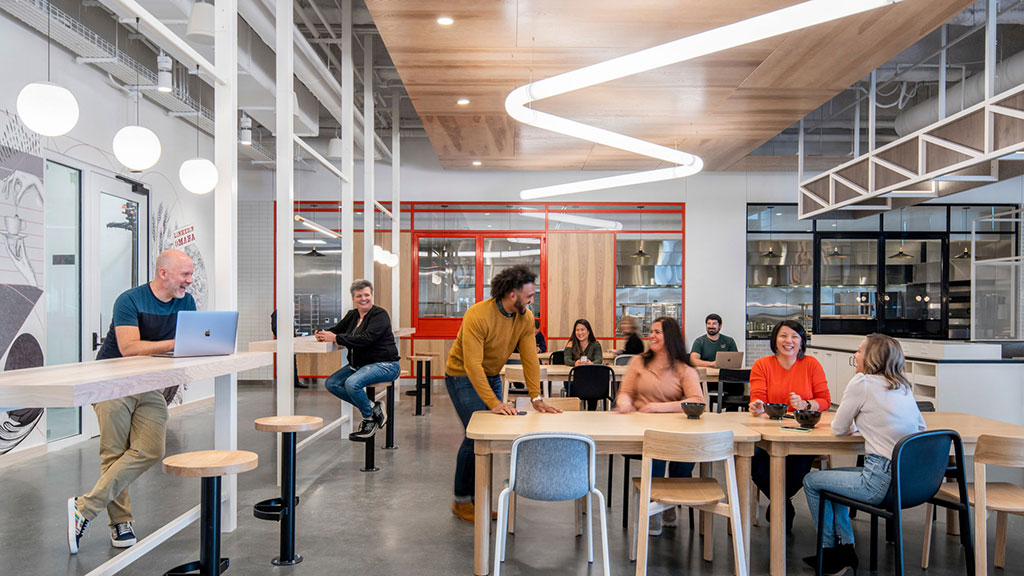Let’s begin to consider designing workspaces for “whole life” living
We’re living in an age where work-life balance is a real challenge. Many people feel overwhelmed and stressed out by their workloads, whether they’re working from home or at an office. In fact, according to a recent study conducted by the American Psychological Association (APA), stress levels among American workers are at an all-time high. It’s no wonder that so many people are looking for ways to improve productivity and well-being in the workplace. Luckily, there are some simple changes that can be made to create an environment that promotes balance between work and life:
The benefits of incorporating designs that support whole life are good for people, organizations, and society.
If a workspace is designed to support whole life, it will increase productivity, retention and satisfaction of employees. These in turn improve organizational performance and profitability.
It also leads to a more engaged workforce that is less likely to become sick or injured at work. This can have enormous financial implications for organizations that are responsible for paying employee benefits or managing healthcare costs.
People feel a sense of balance, purpose and belonging in the workplace.
How do we design the workplace of the future? How can we create a more meaningful, fulfilling workplace?
Rather than designing workspaces solely based on function, we need to start thinking about how they can help us feel. We all want to belong somewhere. We all want a sense of purpose and contribution in our lives; otherwise, what’s the point? Well-designed workspaces will give people this sense of belonging and purpose by encouraging them to engage with their colleagues in ways other than just work-related conversations.
A whole life workplace design also allows for diversity of personalities and preferences.
A whole life workplace design also allows for diversity of personalities and preferences. In today’s 24/7 world, we need to find ways to work effectively without leaving our desks. We have to be flexible in how and when we work, so that we can get the most out of our time spent at work.
We are all different people with different working styles, and therefore require different types of environments for success. Some people like the quietest place possible where they can focus on their task; others prefer a library-like atmosphere where they can chat with colleagues while completing tasks; still others like being able to socialize with their teams during meetings or at lunchtime.
Whole life workplaces recognize this diversity by providing spaces that cater to all personalities and preferences (e.g., private offices, open cubicles). This allows employees who may not naturally mesh well together—such as introverts versus extroverts—to choose their own space within the same company environment instead of being forced into situations that do not fit them personally (i.e., “you must sit next me!”).
There’s a lot of talk about why it’s important to create a workplace that allows for whole life balance.
In the past few years, there has been a lot of talk about why it’s important to create a workplace that allows for whole life balance. In fact, many companies are creating collaboration spaces with flexible furniture and open floor plans, which can help workers get more done by making them feel healthier and happier.
But what does this mean? And how can you support whole life balance in your own workspace?
Some companies have begun to boost their success by introducing valuable wellness programs into their workplaces, increasing:
- Employee retention
- Employee productivity
- Employee satisfaction
- Health of employees
- Engagement with the workplace
There is a lot of research out there about how exposure to nature improves health and well-being.
Designing better workplaces does not just mean indoors. There is a lot of research out there about how exposure to nature improves health and well-being. When we work outside, our bodies are more relaxed, which makes us happier and more productive. We’re also less stressed, which helps us focus on the task at hand instead of stressing out over everything else going on in our lives.
Plus, working outside gives us access to fresh air that can help reduce asthma symptoms, allergies and other respiratory ailments (which may be caused or exacerbated by indoor office conditions). And if you’re lucky enough to have a window in your workspace so you can see trees or birds while working—even better!
It’s about integrating all aspects of living (working, socializing, being) into your workspace.
It’s about integrating all aspects of living (working, socializing, being) into your workspace.
This means that you’re designing spaces to support wellness and stress reduction. You are creating an environment where people can be healthy and joyful in the ways that matter most to them; whether that means eating healthily, meditating or finding time for a swim at lunchtime.
Designing workspaces to support a holistic approach increases productivity and well-being.
How do we know that holistic design increases productivity, wellness and engagement?
- In a study of over 500 employees across almost 50 companies, the average number of sick days per year was reduced by 15% when workspaces were redesigned to promote health.
- When employees had access to natural daylight, they reported being happier and more productive.
- Employees who felt engaged were also 33% more likely to stay with an organization for at least three years.
As a result of these findings and many more like them, our workspace designers have been incorporating elements that foster well-being into their designs since day one.
Whether it’s your local coworking space or corporate office, designing a space for whole wellness is the future of work.
Coworking spaces, including Keller Street CoWork, are well-known for their workspace design. Coworkers want workspaces that encourage spontaneity, and it motivates them to return to work every day.
As corporate offices begin to solve the problem of square footage vs. bodies in seats, they could do well to take the lead of our industry and reimagine their own spaces.
What does it all mean? The key takeaway here is that if you want to be more productive, happier and healthier at work, then your workplace needs to support whole life balance. This means incorporating designs that are suitable for all aspects of living (working, socializing, being) into your workspace.
PHOTO: LinkedIn, Omaha, Nebraska. Photo by Jason O’Rear.


